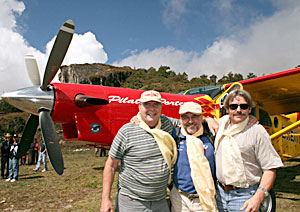 JASON BRYANT HIGH ADVENTURE: Henri Schurch (left), owner of the Pilatus Porter, organiser of the Everest skydiving event, Nigel Gifford of High and Wild (centre), and pilot Ruedi Isenschmid. |
Ruedi Isenschmid and Henri Schurch flew their Pilatus Porter aircraft all the way from the Swiss village of Biel/Bienne to Kathmandu via Bahrain and India, and then on to the disused Syangboche airstrip, the world's highest drop zone at 3,883m.
For 10 days from 2 October, Isenschmid and Schurch took four skydivers at a time up to an altitude of 8,990m above the world's highest mountain so they could freefall down to Syangboche.
On 8 October, the two pilots along with the skydiving team stopped all jumping activities and observed a minute's silence to remember the 18 people who had died in the Lukla plane crash.
Billi Bierling spoke to Isenschmid at Syangboche after he had dropped the first three skydivers to freefall from above the world's highest mountain.
Nepali Times: You have been a professional pilot for more than 30 years. How was this different?
Ruedi Isenschmid: It was a very special and amazing experience. I fly a lot in the Swiss Alps but here you are much closer to the steering limit of the aircraft. It took us an hour to climb to the required height. The scenery is stunning and we flew very close to the 8,000-metre giants and Ama Dablam, the Matterhorn of Asia.
Was there a lot of pressure to perform as many flights as possible? 
We have to do as many flights as possible before the clouds come in, and they normally build up in the valley in the morning. I have to closely observe the clouds and if they accumulate around the airstrip I have to land very quickly. If Syangboche is covered up I either have to go down to the airport in Lukla or go all the way back to Kathmandu.
Is it normal for such a tiny plane to fly to almost 9,000m?
We normally do not fly so high and for this event we needed special permits from the Swiss authorities. The jumpers and I are also using oxygen for this flight. The usual altitude for such an aircraft is about 3,000m to 4,000m.
What is the main challenge in taking off and landing at Syangboche?
When we arrived on 2 October it was the first time a Pilatus Porter had landed here in decades. However, what was much more challenging was the introduction course I and my colleague Henri had to do in Kathmandu for Nepal's aviation authorities. It was all theoretical but the funny thing was that when I asked for the coordinates for Syangboche they did not know them.
How did you find this tiny airstrip without the coordinates?
We got the coordinates for Lukla airport and we found the airstrip using tourist maps I had bought in Kathmandu.
http://www.everestskydive.com/
http://www.highandwild.co.uk/
http://www.swissboogie.ch/


